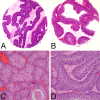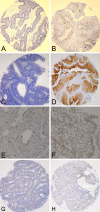Immunohistochemistry and Fluorescence In Situ Hybridization Can Inform the Differential Diagnosis of Low-Grade Noninvasive Urothelial Carcinoma with an Inverted Growth Pattern and Inverted Urothelial Papilloma
- PMID: 26208279
- PMCID: PMC4514649
- DOI: 10.1371/journal.pone.0133530
Immunohistochemistry and Fluorescence In Situ Hybridization Can Inform the Differential Diagnosis of Low-Grade Noninvasive Urothelial Carcinoma with an Inverted Growth Pattern and Inverted Urothelial Papilloma
Abstract
Urothelial carcinoma (UC) comprises a heterogeneous group of epithelial neoplasms with diverse biological behaviors and variable clinical outcomes. Distinguishing UC histological subtypes has become increasingly important because prognoses and therapy can dramatically differ among subtypes. In clinical work, overlapping morphological findings between low-grade noninvasive UC (LGNUC), which exhibits an inverted growth pattern, and inverted urothelial papilloma (IUP) can make subclassification difficult. We propose a combination of immunohistochemistry (IHC) and molecular cytogenetics for subtyping these clinical entities. In our study, tissue microarray immunohistochemical profiles of Ki-67, p53, cytokeratin 20 (CK20) and cyclinD1 were assessed. Molecular genetic alterations such as the gain of chromosomes 3, 7 or 17 or the homozygous loss of 9p21 were also assessed for their usefulness in differentiating these conditions. Based on our analysis, Ki-67 and CK20 may be useful for the differential diagnosis of these two tumor types. Fluorescence in situ hybridization (FISH) can also provide important data in cases in which the malignant nature of an inverted urothelial neoplasm is unclear. LGNUC with an inverted growth pattern that is negative for both Ki-67 and CK20 can be positively detected using FISH.
Conflict of interest statement
Figures





References
-
- Eble JN, Sauter G, Epstein JI, Sesterhenn IA. World Health Organization Classification of Tumors:Pathology and Genetics of Tumours of the Urinary System and Male Genital Organs. Lyon: IARC Press.
-
- Perez-Montiel DÍSS. Upper urinary tract carcinomas: histological types and unusual morphological variants. Diagnostic Histopathology. 2008;14(1):48–54.
-
- Humphrey PA. Urinary bladder pathology 2004: An update. Annals of Diagnostic Pathology. 2004;8(6):380–9. - PubMed
-
- Drew PA, Furman J, Civantos F, Murphy WM. The nested variant of transitional cell carcinoma: an aggressive neoplasm with innocuous histology. Modern pathology: an official journal of the United States and Canadian Academy of Pathology, Inc. 1996;9(10):989–94. - PubMed
MeSH terms
Substances
LinkOut - more resources
Full Text Sources
Other Literature Sources
Research Materials
Miscellaneous

